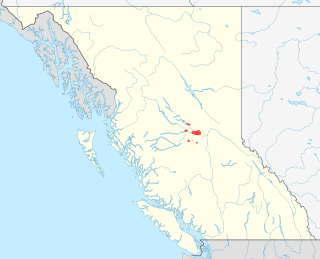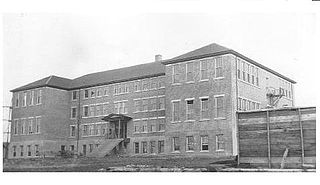
The Dakelh or Carrier are the indigenous people of a large portion of the Central Interior of British Columbia, Canada. Another name the Dakelh/Carrier call themselves is Yinka Dene, the Babine-Witsuwitʼen-speaking bands prefer the equivalent Yinka Whut'en.

The Dene people are an Indigenous group of First Nations who inhabit the northern boreal, subarctic and Arctic regions of Canada. The Dene speak Northern Athabaskan languages and it is the common Athabaskan word for "people". The term "Dene" has two uses:
A tribal council is an association of First Nations bands in Canada, generally along regional, ethnic or linguistic lines.

Sekani or Tse’khene are a First Nations people of the Athabaskan-speaking ethnolinguistic group in the Northern Interior of British Columbia. Their territory includes the Finlay and Parsnip River drainages of the Rocky Mountain Trench. The neighbours of the Sekani are the Babine to the west, Dakelh to the south, Dunneza (Beaver) to the east, and Kaska and Tahltan, to the north, all Athabaskan peoples. In addition, due to the westward spread of the Plains Cree in recent centuries, their neighbours to the east now include Cree communities.
Heiltsuk, Híɫzaqv, also known as Bella Bella and Haihais, is a dialect of the North Wakashan (Kwakiutlan) language Heiltsuk-Oowekyala that is spoken by the Haihai (Xai'xais) and Bella Bella First Nations peoples of the Central Coast region of the Canadian province of British Columbia, around the communities of Bella Bella and Klemtu, British Columbia. Bella Bella is the headquarters of the Heiltsuk Nation government.
Lillooet is a Salishan language of the Interior branch spoken by the Stʼatʼimc in southern British Columbia, Canada, around the middle Fraser and Lillooet Rivers. The language of the Lower Lillooet people uses the name Ucwalmícwts, because St̓át̓imcets means "the language of the people of Sat̓", i.e. the Upper Lillooet of the Fraser River.

Williston Lake is a reservoir created by the W. A. C. Bennett Dam which is located in the Northern Interior of British Columbia, Canada.

The Dakelh (ᑕᗸᒡ) or Carrier language is a Northern Athabaskan language. It is named after the Dakelh people, a First Nations people of the Central Interior of British Columbia, Canada, for whom Carrier has been a common English name derived from French explorers naming of the people. Dakelh people speak two related languages. One, Babine-Witsuwit'en, is sometimes referred to as Northern Carrier. The other includes what are sometimes referred to as Central Carrier and Southern Carrier.
Mary John Sr. CM was a leader of the Carrier people of the central interior of British Columbia in Canada. She was known as "Mary John Sr." to distinguish her from her daughter-in-law, also named Mary John. She became well known both for her political and social activism and as a role model, a person of enormous integrity, strength, and gentleness.
Edward John is a prominent First Nations political leader in Canada.
Tl'azt'en Nation is a First Nations band located along the north shore of Stuart Lake near the outlet of the Tache River, in the northern interior of British Columbia. The main village belonging to Tl'azt'en Nation is Tache, 60 km north-west of Fort St. James.The small settlements of Middle River (Dzit'lain'li).on Trembleur Lake and Grand Rapids, along the Tache River between Stuart Lake and Trembleur Lake also belong to Tl'azt'en Nation. The main administrative offices are in Tache, as a school - Eugene Joseph Elementary School, Daycare, Head Start, Health Unit, Education Centre/ Learning Centre for Adults, RCMP/ Justice Office, Public Works building that supplies diesel and gasoline, water treatment plant, a newly built youth recreation center (2012), a Catholic and Christian church, one in Old Tache and one in "sunny side", a volunteer fire department with a fire hall; rec sites include a paintball park, a basketball court and a hockey rink. The village of Portage once belonged to Tla'zt'en Nation but separated in 1994 as Yekooche First Nation. The village of Pinchie once belonged to Tl'azt'en Nation separated on March 12, 2019 and is now the Binche Whut'en First Nation Prior to 1988 Tl'azt'en Nation was known as the Stuart-Trembleur band. Tl'azt'en Nation belongs to the Carrier Sekani Tribal Council.
The Carrier Sekani Tribal Council is a tribal council representing six First Nations in the Central Interior of British Columbia. It was originally known as the Lakes District Tribal Council. The CSTC was incorporated in 1981 and is a registered non-profit society.

Lejac Residential School was a Canadian residential school in British Columbia that operated from 1922 to 1976 by the Roman Catholic Church under contract with the Government of Canada.

The Nadleh Whut'en First Nation is a First Nations government of the Dakelh people, whose territory is located in the Central Interior of British Columbia, Canada, around the east end of Fraser Lake. The nation has seven reserves which Crown-Indigenous Relations and Northern Development Canada refer to as IR#1-9.. Until 1990, it was referred to as the Fraser Lake Indian Band.

Bridget Moran, née Drugan, was a Canadian social activist and author in British Columbia. Born in Enniskillen, County Fermanagh, Northern Ireland, shortly after her birth her family emigrated to Success, Saskatchewan, where she grew up.
Nak'azdli Whut'en is a Dakelh First Nation band with a main community located next to the village of Fort St. James, British Columbia. The nation has 16 reserves totalling 1,458 hectares, and approximately 1977 members living both on - and off reserve. The Nak'azdli Band chief is Aileen Prince.
The Cheslatta Carrier Nation or Cheslatta T'En, of the Dakelh or Carrier people (Ta-cullies, meaning "people who go upon water" is a First Nation of the Nechako River at the headwaters of the Fraser River.
Lhtako is the name of the tribe of Dakelh (Carrier) people who are today headquartered at Quesnel, British Columbia and incorporated under the Indian Act as the Red Bluff First Nation. Their southern neighbours are the T'exelc group of the Northern Secwepemc to the south, the Nazko people and Lhook'uz people to the west, the Tsilhqot'in peoples to the southwest, and the Lheidli Tenneh people to the north. Their territory borders with that of the Sekani on the northwest side of the Cariboo Mountains also. They are the southeasternmost of British Columbia's Athapaskan-speaking tribes.
William J. Poser is a Canadian-American linguist who is known for his extensive work with the historical linguistics of Native American languages, especially those of the Athabascan family.
Justa Monk (1942-2018) was a leader of the Dakelh people of the central interior of British Columbia. He was known as a strong advocate for indigenous rights, for protection of the environment, especially fishery, and for the maintenance of his Carrier language. The first part of his life was documented in a full-length biography by Bridget Moran.







